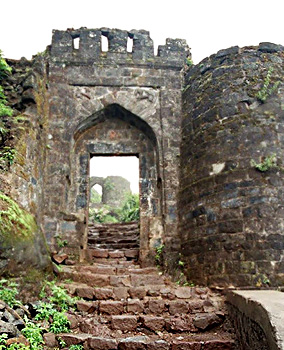 Conquests of Shivaji figure many in number. His desire to unite the Marathas and overthrow the yoke of Muslim rule was a rather strong factor which drove him towards his many conquests. There are differences of opinion as to which fort first fell into Shivaji`s hands. A Muslim chronicler gives Shivaji`s first prize as Chandanwandan, which does not seem correct because this fort is in Satara district. The more popular version of history is that he first turned to Torna, some twenty miles south-west of Poona. It is believed that in the year 1645, at the tender age of sixteen, he carried out his first military action by capturing the fort at Torna in the kingdom of Bijapur.
Conquests of Shivaji figure many in number. His desire to unite the Marathas and overthrow the yoke of Muslim rule was a rather strong factor which drove him towards his many conquests. There are differences of opinion as to which fort first fell into Shivaji`s hands. A Muslim chronicler gives Shivaji`s first prize as Chandanwandan, which does not seem correct because this fort is in Satara district. The more popular version of history is that he first turned to Torna, some twenty miles south-west of Poona. It is believed that in the year 1645, at the tender age of sixteen, he carried out his first military action by capturing the fort at Torna in the kingdom of Bijapur.
By 1647 he had captured the forts of Kondana and Rajgad and had control of much of the southern Pune region. Kondana was quite close to Pune. As a result, Shivaji expected to meet with strong resistance from the Muslim governor-in-charge. So he bribed His Excellency rather than overpower him. Corruption had already set in at the court of Bijapur and as news of this moral laxity trickled to the outposts, the loyalty of officials to the Sultan suffered. Kondana, renovated and overhauled was given the name of Sinhagarh fort, the fort of the lion.
Shivaji then turned to the fort of Purandhar. This fort was important for the safety of the districts that were already in his hands, of which Supa was the best known. Purandhar presented certain difficulties in its capture. The fort was in the hands of a Brahmin. Shivaji could not have risked open assault on a Brahmin possession as this would have injured Hindu sentiments.
It was in the possession of a Brahmin, Nilkant Rao, who held it together with the neighbouring lands which he had received in inam (reward) from the Nizam Shahs. The Brahmin had been friendly to Shivaji, his neighbour, till he died. Now the three sons of Nilkantrao who inherited the estate were warring among themselves claiming bits and pieces of the estate; the oldest, Nilopantrao, trying to dictate terms to his two younger brothers. Here too, Shivaji managed to rather diplomatically capture the fort keeping friends close and not hurting anyone`s interests.
Shivaji next captured his father`s fort of Visapur, guarded by an Abyssinian on Shahaji`s behalf. He offered to let the Abyssinian remain in charge, but when the latter shouted abuse in return, Shivaji, unruffled by this rudeness, packed the Abyssinian off.
By 1654 Shivaji had captured forts in the Western Ghats mountain range and along the Konkan coast.



















